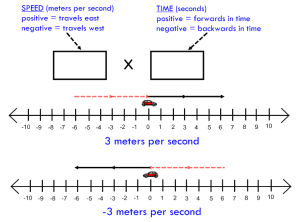So there’s a whole lot of posts, including one from this very blog, which give intuitive explanations of why a negative times a negative is a positive.
I haven’t seen nearly as much material for a negative divided by a negative. One can certainly appeal to the inverse — since ,
. Google searching leads to answers like that, but I’ve found nothing like the multiplication picture above.
Can anyone explain directly, at an intuitive level, why a negative divided by a negative is a positive? Or is the only way to do it to refer to multiplication?
Filed under: Education, Mathematics |



You could use exactly the same picture with the car, but list SPEED and DISTANCE at the top, with a division sign between them. Then make timelines instead of number lines, with 0 = now.
I’ll have to try that (I believe I have the original stuff I used to make the image file, eek, 5 years ago).
How many -5’s are in -15?
This is exactly the sort of thing I’m aiming at … could we take this farther with intuitive analogies? That is, could we have physical things the -15 and -5 represent?
The temperature goes down 5 degrees a day, how many days until it goes down 15 degrees?
That works.
It seems like the “hard case” here is actually a negative divided by a positive or vice versa. (“The temperature goes up 5 degrees a day, how many days until it goes down 15 degrees” doesn’t make sense.)
Well, it makes sense if we don’t let the way we talk about time mess us up.
The temperature goes up 5 degrees a day, on what day is it down 15 degrees. (3 days ago)
Pretty solid. That would even work in picture form.
3
3
Reblogged this on Singapore Maths Tuition.
I have explained it using multiplication as repeated addition. Take 2×3 for example, that is 0+2+2+2 = 6, while 2x(-3) would be 0+-2+-2+-2 = -6, so (-2)x(-3) would be 0-(-2)-(-2)-(-2)=6. The negative sign refers to the opposite, of repeatedly adding, which would mean repeatedly subtracting the negative.
The problem with “intuitive analogies” is that they are not mathematical. Not like “How many -5’s are in -15?”
How many -5s are in -15 is also ambiguous for the mental model of a student (how many 5s are in -15? could also lead to “3” by the same visualization).
But that is exactly the ambiguity that mathematical reasoning sorts out. That is the central point. To form a theory of the real numbers that is consistent throughout. -15 divided by 5 cannot be 3 because that would lead to a contradiction with other statements. Physical examples have their place in this journey. We are so accustomed to our physical senses that it is only natural that we want to relate mathematics to them. Beyond being an exercise in logic and reasoning, we want our conclusions to jive with what we see with our eyes. But thinking mathematically is still the challenge, not feeling. You can’t rely on physical examples to sort out the reasoning behind negative numbers.
My stupidly simple question is “When does one first encounter the need for an answer to this question? “. It is certainly not when dealing with temperature, heights above sea level etc. It is mathematically sensible to consider the signed numbers as a one dimensional vector space, so that in a division the numerator is a vector and the denominator is a scalar multiple.
I used the example -30 divided by 3 is -10 using money and the following scenario:
Three of us went out to eat. The bill was $30, how much would each of us owe?